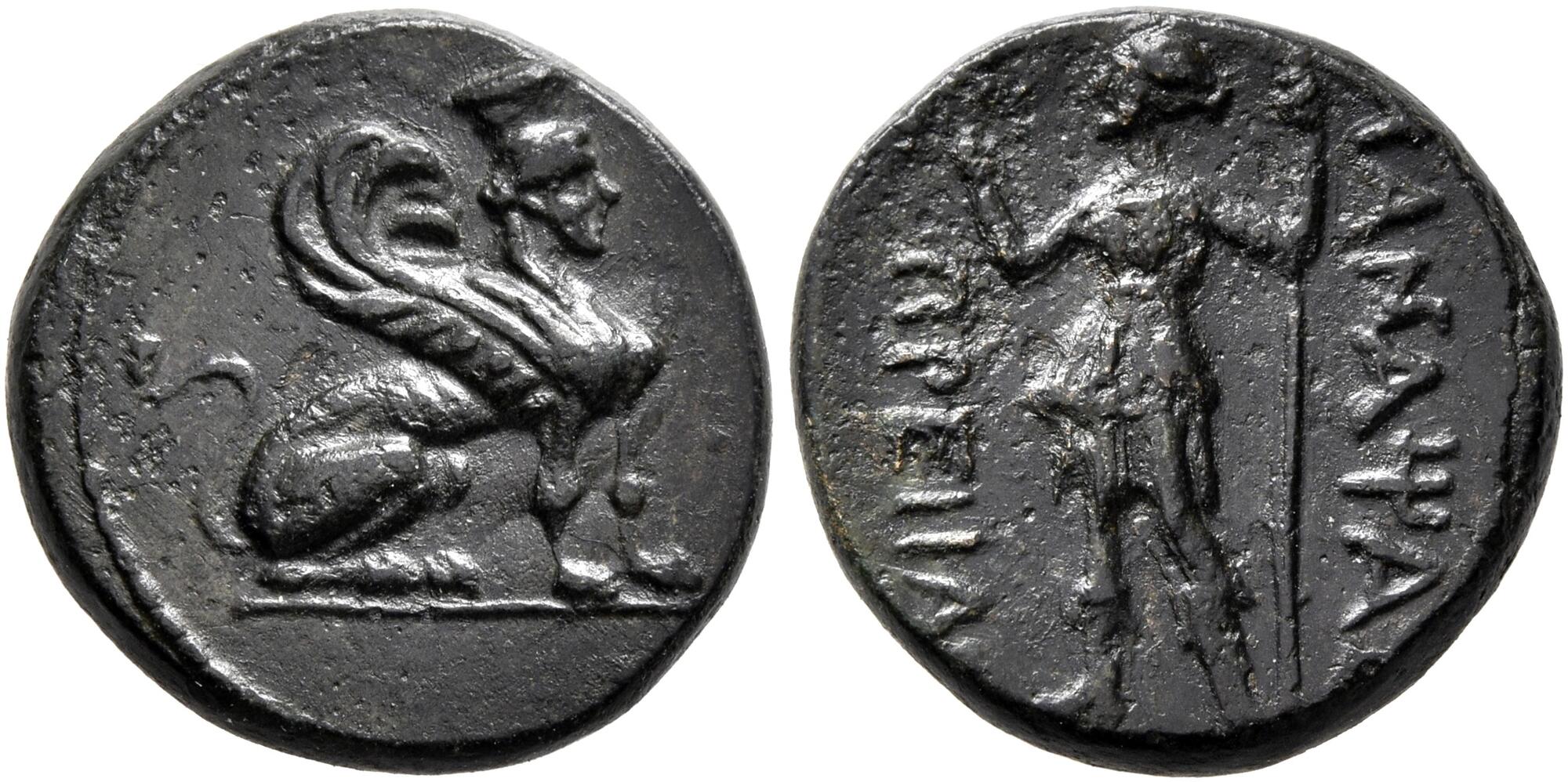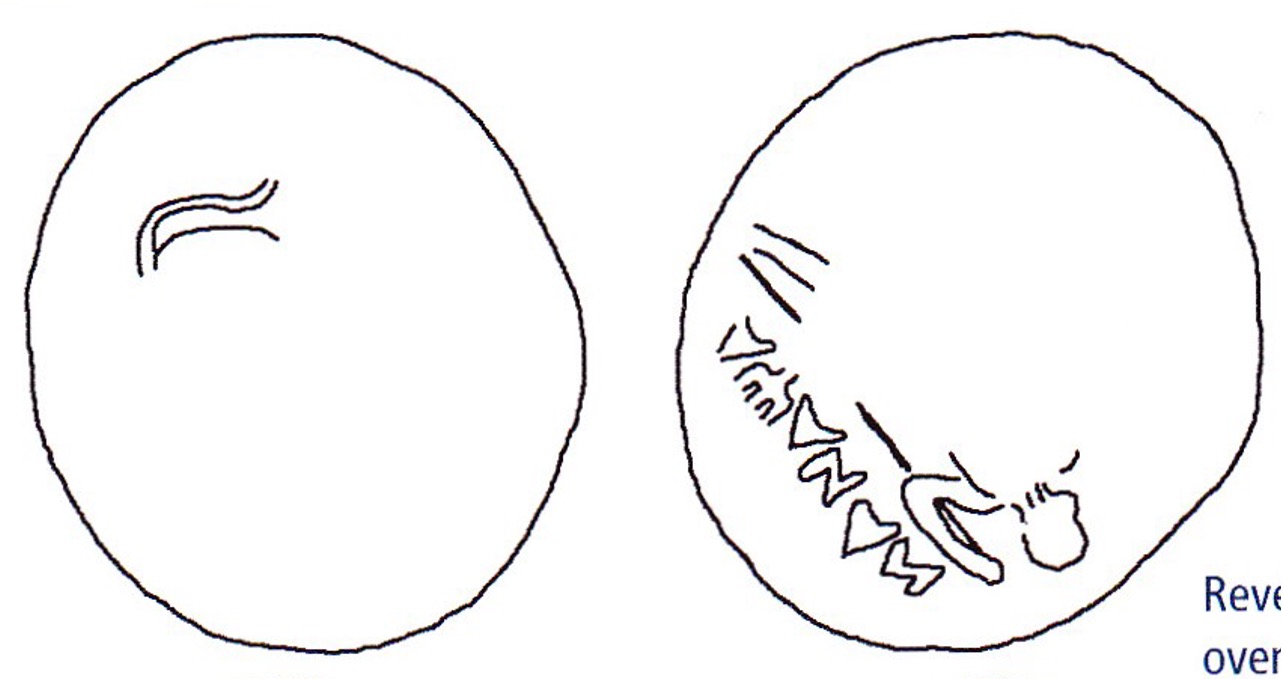2931 - Etenna (AE nymph/knife) over Perge (sphinx/Artemis) (MacDonald coll., 133)
From SILVER
100 BCE - 30 BCE | ΕΤ
Images
Overstruck variety Traces of the overstruck variety
Traces of the overstruck variety

Perge_sphinx-Athena.jpeg [1]
Location/history
| Private collection(s)Private collection(s) ᵖ: | David MacDonald collection |
Overstriking coin
Description
| ObverseInscription or printing placed on the obverse.: | Nymph facing, with serpent wrapped around her. Behind, overturned oinochoe. | ReverseInscription or printing placed on the reverse.: | ΕΤ (Greek) Sickle-shaped knife. |
Mint and issuing power
| MintIdentifies the place of manufacture or issue of a numismatic object.: | Etenna | Ancient regionAncient region. | Pisidia | Modern countryModern country: Turkey | AuthorityIdentifies the issuing power. The authority can be "pretended" when the name or the portrait of X is on the coin but he/she was not the issuing power. It can also be "uncertain" when there is no mention of X on the coin but he/she was the issuing power according to the historical sources: |
Chronology
| FromIdentifies the initial date in a range assigned in a numismatic context. 100 BCE toIdentifies the final date in a range assigned in a numismatic context.. 30 BCE | Hellenistic 323-30 BC |
Physical description
| MetalThe physical material (usually metal) from which an object is made.: Bronze |
WeightWeight of the numismatic object (in grams). in grams: 3.283.28 g <br />3,280 mg <br /> | AxisDescribes the directional relationship between the obverse and reverse of a numismatic object.: 55 mm <br />0.5 cm <br /> | |
| DiameterDescribes diameter of an object (in mm).: 2020 mm <br />2 cm <br /> | |||
References
| Coin referenceReference of the Coin: | MacDonald 2009, p. 178, n° 133. | Coin series referenceReference to coin series study: | SNG Copenhagen Pisidia1SNG Copenhagen Pisidia, n° 146, SNG von Aulock Pisidien2SNG von Aulock Pisidien, n° 5018, SNG France 33SNG France 3, n° 1538-1540 |
| Coin series web referenceCoin series web references: | |||
Overstruck type
Description
| ObverseInscription or printing placed on the obverse.: | Sphinx seated right, wearing polos (visible on obverse: tail and rump). | ReverseInscription or printing placed on the reverse.: | ΝΑΝΑΨΑΣ ΠΕΡΓΑΣ (Greek) Artemis standing left, holding long scepter and wreath (visible on reverse: head, arm, and leg of Artemis, long scepter, letters). |
Mint and issuing power
| MintIdentifies the place of manufacture or issue of a numismatic object. ᵖ: | Perge | Ancient regionAncient region. ᵖ | Pamphylia | Modern countryModern country: Turkey | AuthorityIdentifies the authority in whose name (explicitly or implicitly) a numismatic object was issued. ᵖ: |
Chronology
| FromIdentifies the initial date in a range assigned in a numismatic context. 260 BCE toIdentifies the final date in a range assigned in a numismatic context.. 100 BCE | Hellenistic 323-30 BC |
Physical description
References
| Coin type referenceReference to coin series study ᵖ: | SNG Copenhagen Lycia-Pamphylia4SNG Copenhagen Lycia-Pamphylia, n° 310-311, SNG von Aulock Pamphylien5SNG von Aulock Pamphylien, n° 4649-4650, SNG France 33SNG France 3, n° 355-368, Colin 19966Colin 1996, n° 2-2.7, p. 50-57, pl. 27-34 | ||
| Coin series web reference overstruckCoin series web references overstruck: | |||
Additional data
| Frequency of overstrikesFrequency of overstrikes: | frequent | Level of confidenceLevel of confidence of the identification: | sure |
| RemarksRemarks: | |||
References
- ^ Breitenstein, Niels (1956), Sylloge Nummorum Graecorum: Royal Collections of coins and medals. Danish National Museum, 32, Pisidia.
- ^ Sylloge Nummorum Graecorum. Sammlung v. Aulock. Pisidien - Lykaonien - Isaurien. 12 Heft (n° 4894-5412), Berlin, 1964.
- a b Levante, Edoardo [with the collaboration of Peter Weiss] (2001), Sylloge nummorum graecorum. France. 3, Département des monnaies, médailles et antiques : Pamphylie, Pisidie, Lyaconie, Galatie, Paris-Zürich, Bibliothèque nationale de France-Numismatica Ars Classica, XXXIV + 293 p. and 146 pl.
- ^ Breitenstein, Niels (1955), Sylloge Nummorum Graecorum: Royal Collections of coins and medals. Danish National Museum, 31, Lycia-Pamphylia.
- ^ Sylloge Nummorum Graecorum. Sammlung v. Aulock. Pamphylien. 11 Heft (n° 4477-4893), Berlin, 1965.
- ^ Colin, Hans J. (1996), Die Münzen von Perge in Pamphylien aus hellenistischer Zeit, Köln, Kölner Münzkabinett Tyll Kroha, 101 p., 50 pl.

